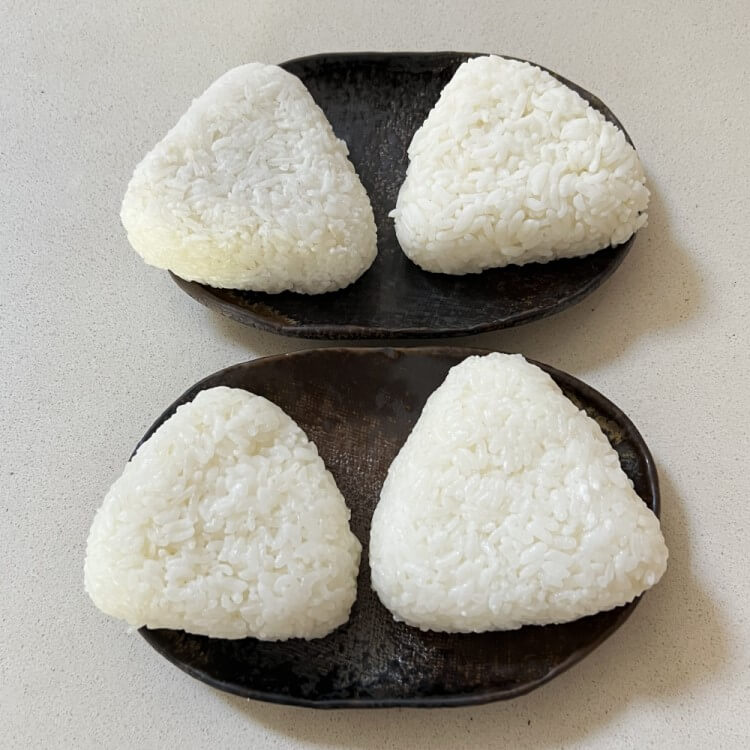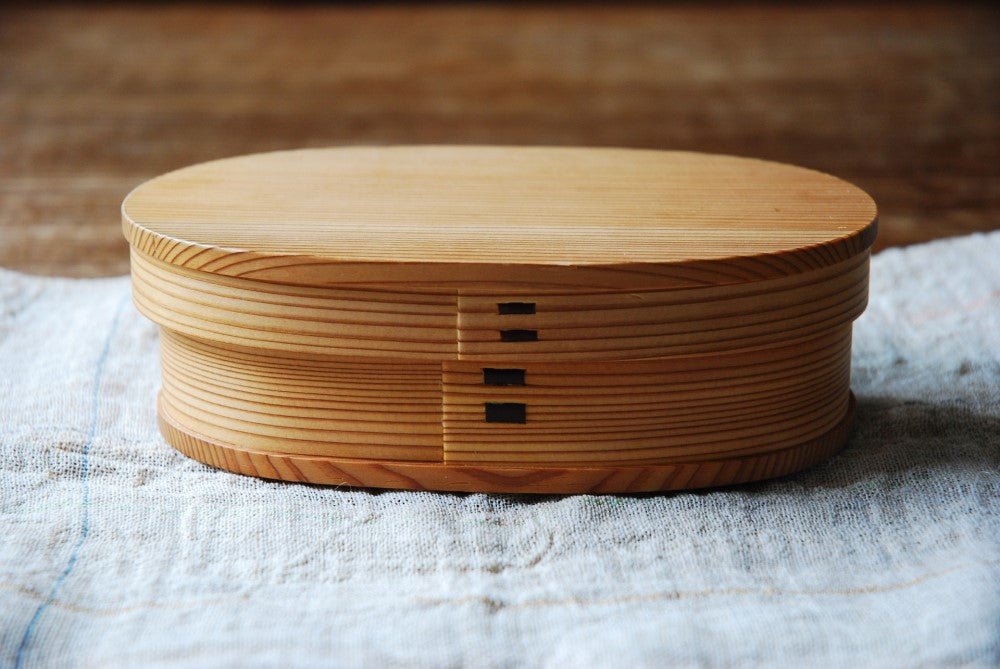In this article, we tested making triangular onigiri with three varieties of rice that are available from Australian grocery stores. Short and medium grain rice are usually recommended for shaping the onigiri, but we found that long grain jasmine rice also did the job. Read on!
Brief background on onigiri
In Japan, making onigiri (riceballs) is such a routine practice that we often don’t question some basic processes like washing rice, soaking rice, using a rice cooker, let alone the variety of rice to use. Using short grain rice is a given, but more on that soon.
Historically, onigiri was made as a convenient food to take on the go. They would be eaten by samurai on the road or farmers working in the fields. To keep the rice from spoiling too quickly, salt or sour ingredients would be added to the rice, and then compacted and packed so they could be readily eaten with just hands. These days, it’s become a global iconic Japanese food that’s on par with sushi.
The most important ingredient for onigiri is the rice, in particular short grain rice. It’s often recommended to use a Japonica rice variety due to its sticky and starchy texture so that the onigiri can maintain its shape. It also has a slightly sweet taste and is chewy, which makes it ideal to have by itself or with other ingredients and fillings.
So, what happens if you don’t use short grain rice, or technically, rice that doesn't have a sticky consistency? Well, the onigiri will most likely fall apart making it awkward to eat, especially on the go, defeating the purpose of it being a convenient hand eaten food. But did you know that there are also methods to wrap the rice to maintain its shape? (Look for the 'onigirazu' section in this article.)
Types of rice
There are 3 main types of rice – long grain, medium grain and short grain rice. The recommended variety to use for onigiri is short grain rice due to its stickiness and chewy texture. These characteristics are due to its high starch and moisture content, perfect for what we’ve come to expect of Japanese cuisine.
Medium grain rice can also be used to make onigiri as it also has a sticky characteristic due to its relatively high start content, although not on par with short grain rice.
It’s said that long-grain rice is not great for onigiri as it will fall apart when trying to mould it into shape, as the grains are just not sticky enough. But we find out that this is not always the case. Perhaps more than that, the fluffy and firm texture of the grains, as well the fragrance, may just not be a good fit for that 'onigiri-taste'.
Rice grains before cooking
We initially used 4 types of rice available locally here in Sydney, Australia for our little ‘investigation’. The first 3 are from the Australian brand, Sun Rice. These were Jasmine rice (a long grain variety), medium grain white rice, and sushi rice (a short grain variety). The 4th variety was an imported short grain rice from Miyagi prefecture, Japan. It is called ‘Hitomebore’, a popular rice variety in Japan. Here are the pictures of the packages.

We also used a pre-cooked basmati rice variety from Sun Rice, another long grain rice variety.

Now let’s take a closer look at the grains.

You can clearly see the difference between the long grain jasmine and medium grain rice. The short grain rice were pretty similar to each other, but what we noticed is that the size and shape of the imported Japanese rice grains were much more consistent between one another, most likely reflecting the difference in the techniques of milling process. Interesting!
What does the rice look like after being cooked?
Rice were cooked under the same settings of a TIGER brand rice cooker, using two cups of rice in two cups of water. The basmati rice was already precooked, so we just had to microwave it.
Here are what the grains look like in the cooked state. It was actually quite difficult to see the differences between the grains for all the rice types. All grains appeared to be sticking to one another, including the Jasmine rice.

The basmati rice, however, was clearly the outlier. The grains didn't stick together at all, and were easily separated when 'fluffed'. Here are what they look like.

Onigiri shapes
Before we show the onigiri making results, here’s a brief explanation about the different shapes of onigiri. A triangular shape is probably what one might think of when thinking about an onigiri. But there are actually different shapes of onigiri that originated from different parts of Japan for various reasons.
- Triangle shape
This is the mainstream shape throughout Japan now because of the ease of making and ease of holding. The shape has also been made popular because of the spread of convenience stores in Japan, with their shelves stacked mostly with triangular onigiri (albeit there are certainly other shapes). Seven-Eleven Japan started selling triangular onigiri in 1978, and its popularity has spread alongside convenience stores.

- Bale/drum shape
Historically, this used to be the mainstream shape in the Kansai region. It is thought that this shape was easier to pack into the makunouchi bento lunch boxes that were served when going to see a play during those times. This shape was easier to pack than triangular or other shapes and was easier to pick with chopsticks.

- Ball/spherical shape
This is probably the oldest shape of onigiri and was popular in the Chubu region (such as Aichi prefecture) of Japan. It’s said to be a popular shape for the ‘common’ people who made them with scraps of vegetables and eaten between farm work.

- Disc shape
Popular in the cold Tohoku region, these disc shaped onigiri are round but flatter, making it easier to spread miso paste on them and bake.

Making onigiri with the different rice varieties
We made triangular onigiri by hand (with plastic wrap) with the different rice varieties. Not surprisingly, the medium and short grain rice were able to easily stick together and not break apart. But the long grain jasmine rice was also able to hold its shape without falling apart. Since it is often suggested that long grain rice couldn't be used to make onigiri because it won't stick together, we tested out another long grain rice variety - basmati rice. This final test was conclusive - the basmati rice crumbled as soon as the plastic wrap was removed.
Watch the YouTube videos below showing the making of onigiri with each rice type.
Making onigiri with jasmine long grain rice:
Making onigiri with medium grain rice:
Making onigiri with sushi short grain rice:
Making onigiri with Japanese 'hitomebore' short grain rice:
Making onigiri with basmati long grain rice:
By the way, the triangle onigiri were made with hands in these demonstrations. It can take a little bit of practice to get used to moulding the rice into shape. If you are after a more consistent and convenient way to make a trianglular onigiri, try out these onigiri bento case and mould (and a larger version).
Onigirazu
On a side note, there is a different method of making ‘onigiri’ where you do not need to mould the rice into a desired shape. This is called ‘onigirazu’, which literally translates to ‘not pressed’. The ‘nori’ (seaweed) plays an important role in this type of onigiri as it is needed to cover and hold the rice together.
- Triangle onigirazu
A square seaweed is cut into two right-angled triangles. The rice is usually placed at the centre of the cut seaweed, and by folding the sides over the rice, you can cover the rice to form a triangle shape.

- Sandwich onigirazu
By placing the rice into quadrants on a square piece of seaweed, and then folding onto each other, you can create a square shaped onigiri covered with seaweed on all sides. Then if you cut it half, it essentially becomes a rice sandwich.
We were able to make a triangle onigirazu with the jasmine long grain rice. See this video.
Use this technique for making onigiri with less sticky rice, or if you want an ‘onigiri’ without actually having to mould it. We also have an 'onigirazu rice sandwich maker' in our store.
Onigiri taste test
All onigiris in this article were taste tested by Majime Life and for obvious reasons, the opinions here are subjective. The imported Japanese ‘Hitomebore’ rice tasted the best (of course!). The texture was perfect, slowly dissolving with every chewy bite. Even without any fillings, it had a very subtle sweetness. The onigiri made with the medium grain and sushi rice were not bad at all, although they felt a little firm. Still chewy, but less flavourful. These rice types are cost-effective alternatives if you have a craving for onigiri every day, and you can easily find them in Australian supermarkets.
While the long grain jasmine rice unexpectedly held itself together when moulded, to someone who is used to eating onigiri made with Japanese rice, it just didn’t seem to work. The smell was a little too fragrant, and it left a somewhat dry feeling in the mouth.
It all comes down to preference. So if you have leftover rice you need to use, then don’t let the grain type stop you from making an easy to eat onigiri!
Verdict
As we expected, onigiri made with the medium and short grain rice easily kept its shape. And although long grain rice is generally thought not to be suitable for onigiri due to its lack of stickiness, the Sun Rice long grain jasmine rice used here actually held together well enough to maintain its shape. The Sun Rice Basmati rice on the other hand just crumbled, as it had no sticky consistency at all.
While the taste and texture of different rice varieties for onigiri will be a matter of preference, you should have plenty of access to short or medium grain rice (at least in Australia) to make your perfect onigiri. Just avoid basmati rice!
Have fun ‘onigiring’!


